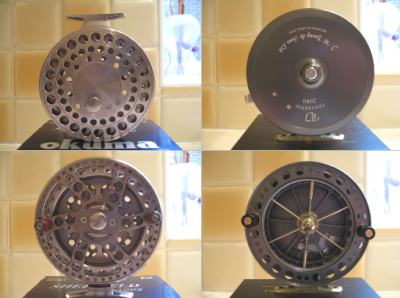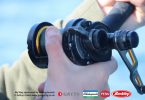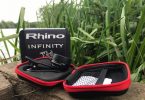Back in March 2008 I decided to learn the art of ‘pin fishing and after trawling reviews of various reels I was faced with the same difficult choice all first timers have to make. Should I buy a functional reel that will do the job or something that will also look nice on the mantelpiece? Eventually I chose the Okuma Sheffield; shop around and they’re available for £100 or so.
A couple of months later I was in a position to buy another reel, but this time I wanted something a bit more traditional that could be a keepsake, so a J W Young Bob James model was added to the collection….at double the cost of the Okuma.
Having used both for a few outings now, I‘ve been thinking about which reel represents the best value; is the Young twice as good as the Okuma, or is it a masterpiece of form over function? Read on.
Size matters?
Both reels are 41/2 inch diameter, the Okuma has a 3/4“ wide spool and the Young 1”. I haven’t noticed the spool width making much difference in use. Neither reel suffered from significant line bedding after catching a fish but then I only use about 40m of line on each reel.
Weight
Not much in it at all; 242g (Young) and 247g (Okuma). Neither reel felt unduly heavy in use. More interesting is the Okuma spool weighing in at a hefty 157g with the Young spool a svelte 131g – that’s a 20% difference.
Features
The Okuma is pretty sparse in terms of features; a ratchet operated by a button on the back of the reel and that’s about it. Not that convenient to use whilst playing a fish, but it is quite strong and consistent in both directions. The Young gets a ratchet, drag setting and a quick release spool. The ratchet is operated by a lever which is easier to use than the Okuma’s button. Frustratingly though, the Young’s ratchet is quite weak in one direction and line will easily be taken of the reel if it catches on anything while moving swims. Not an issue if you fish with the line coming off the top of the reel or you’re left handed….but I don’t and I’m not.
For the batters, both reels feature removable handles, and for the Wallis casters neither has a line guard.
Aesthetics
No contest, the Okuma looks shiny, polished and efficient but the Young looks like a centrepin should, brass bits everywhere, levers and catches to play with and an intimate view of the ratchet mechanism. Advantage Young.

Spin Duration
Academic in terms of performance but still good fun trying to keep them going for as long as possible. After a lube of both reels’ bearings and a vigorous flick, the Okuma takes pole position with a rather impressive 3 minutes. The Young languishes down the grid, struggling to reach 45 seconds. Repeated tests gave consistent results which is to be expected given the Okuma’s heavier spool, but I’d rather hoped for more of the Young.
Getting Started
More important than spin duration is what it takes to get the spool moving. In the absence of a babbling brook running through my kitchen, I had to precariously balance £300 worth of fishing reels on the work surface with a foot of line dangling over the edge. I then added split shot to the line until the weight was sufficient to move the spool.
A single AB (0.6g) got the Okuma going, whereas the Young would set off with a single BB (0.4g). Not what I expected, I have to say.
Design & Construction
The Okuma is a robust, no nonsense design, constructed and finished very well with not a rivet in sight (they can loosen in time). The spool retention mechanism is well thought out, allowing the ballraces to do their job unhindered and can easily be dismantled for cleaning. A large knurled screw tightens against an ‘O’ ring taking up any spool end float without applying excessive load to the bearings. I’ve no doubt the ‘O’ ring will compress or harden in time, reducing its effectiveness, but the 5 year warranty provides some comfort that this won’t happen for a while. Given the Okuma’s price range, the quality of this reel is very impressive. The spool runs true and the machined finish is very good.

The Young is also a quality piece of kit, with only the use of rivets to retain the ratchet mechanism letting it down. Features like the spokes, handle seats, drag mechanism, spool release mechanism, spool hub and the dovetailed reel foot all contribute to production costs and so the higher selling price starts to make sense. It is beautifully manufactured and a pleasure to look at, although I’m not sure I’d like to dismantle it for cleaning. It’s difficult to see how it comes apart.
The one issue I have with the Young is that the design is based on a ‘true’ centrepin, where the spool bears on the very tip of the pin. The spool release and drag adjustment both act on the ‘pin and there’s a small grubscrew to adjust end float in the centre of the spool hub (adjusted and glued in at the factory). These are features I’d expect on a reel which needs to be run in and then re-adjusted as it loosens, but on a reel fitted with ballraces, end float is not necessary. Mine has about 20 thou, which doesn’t sound much, but does cause annoying rattles when batting.
I phoned Young to check that I hadn’t bought a faulty reel and they confirmed that all was well. Not a major issue, I just feel that if a reel is designed around ballraces it makes sense to ensure that the rest of the reel benefits from their use.

In use
Now the fun bit, none of the above means anything if the reel isn’t enjoyable to use.
I chose a stretch of the Lambourn near Newbury, which on the day was well down with some parts running very slowly. Not too easy for the reels, then. The rod used was a Drennan MkII 14ft float rod. 6lb line was loaded onto both reels and end tackle was a 2 SSG loafer with a size 14 hook.
Both reels coped with the flow very well with no discernible difference between the two. Take up was very good, with neither reel needing a helping hand to get going. In faster water, both reels would cope with a lighter float. The Okuma’s heavier spool meant that on occasions its momentum had to be checked if the float moved into slacker water. Not an issue really, as skilled trotters will tell you (I’m not one by the way). The Young didn’t ‘suffer’ from this trait, as it’s not as free running.
In the slow flow I didn’t need to use the Young’s drag mechanism and I’m struggling to think where such a feature would be better than a good old fashioned thumb applied to the spool. Perhaps more knowledgeable river fishermen could help me with that.
Removing the Young’s spool to clean crud from the back plate was a doddle and could be accomplished in seconds. More hassle on the Okuma as the knurled nut has to be unscrewed and could then be dropped (don’t ask!). Over the day’s session, neither reel a
ccumulated sufficient crud to need cleaning and line becoming trapped behind the spool just didn’t occur. The Okuma does have a tendency to wrap line around the handles, perhaps because of the narrower spool.
The Young’s lever operated ratchet was much more convenient to use than the Okuma’s button operated mechanism, particularly when lowering the float to re-bait and re cast. The Okuma needed two hands for this. Moving between swims, however, allowed the Okuma to get one back; the ratchet is stronger and it doesn’t have a lever to inadvertently knock off ( I had to sort out a couple of minor birds nests when using the Young).
Cleaning the Okuma at the end of the day was straightforward; it can be dismantled to its constituent parts very easily. You can even remove the bearing shields and flush the bearings if you want to. The Young is a bit more tricky; to access the bearings, a circlip has to be removed (I think) and even then it’s not clear how it comes apart. I’ll be leaving well alone unless the bearings become noisy or rough.
Conclusion
I’m happy to say that both reels acquitted themselves very well with no major design flaws becoming apparent. Each has its features and foibles and I consider myself lucky to own both.
However, not everybody would want to own both and so if you’re after an everyday reel which performs well and doesn’t make trotting a pain (poor centrepins can be very frustrating), is the Young worth the extra cash? In my opinion the answer is a definite NO. The Okuma Sheffield is a remarkable piece of kit for the money and does everything the more expensive Young does. It is built down to a price and you will need to tolerate the button ratchet but the extra £100 saved could buy a very nice float rod to complement the reel.
Be aware though, logic doesn’t always prevail when considering how many centrepins you need to own. Before you know it, there’ll be two or three in your collection.
Now how do I place an order for the AN ‘pin?
Review by Anglers’ Net forum member, Rusty.








